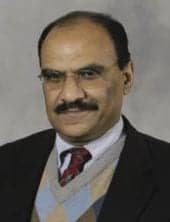Top Doctor Mansoor Ahmed, MD, FCCP, DABSM, has made compassion a cornerstone of his practice, and the profits have followed.

Mansoor Ahmed, MD, FCCP, DABSM
While growing up in Pakistan, Mansoor Ahmed, MD, FCCP, DABSM, was taught by his parents to treat others compassionately and generously. At the same time, they helped to inspire an interest in science and medicine. His family was well known in the small town in which he lived, and poorer citizens would come to them for aid. “I used to take them to a medical doctor because I was not even a medical student but my mom wanted me to help them out,” Ahmed says.
The experience also taught him that one individual can make a big difference. These lessons—and a “hatred for mathematics”—drove him toward clinical medicine, and today he is the medical director of Cleveland Sleep Centers and on the faculty of medicine and international health at Case Western Reserve University (CWRU) in Cleveland, Ohio. Throughout his career, a philanthropic nature has remained evident.
The practice philosophy of Cleveland Sleep Centers has been adopted, with permission from Merck and Company Inc, of Whitehouse Station, NJ, which states: “We try never to forget that medicine is for the people; it’s not for the profits. The profits will follow, and if we have remembered that, they have never failed to appear.” The statement was made by George W. Merck, son of the Merck Pharmaceuticals founder, in 1950, after giving away the patents for streptomycin 4 years earlier to make the life-saving drug more affordable.
Ahmed seeks to make a good night’s sleep—and the resulting impact on health and quality of life—accessible to everyone. The center accepts all patients, regardless of insurance status, and works with them to develop a payment plan consistent with their financial portfolio. A pro bono program enables the center to refuse service to no one.
Ahmed has also devoted much of his time to educational efforts, both regionally and globally. “One of the best ways to improve health care is through educational initiatives,” he says. Through his work with the American Academy of Sleep Medicine (AASM), he developed a sleep training mini-fellowship for international fellows who then return to their home countries, in some cases, to start the nation’s first sleep center. The benefit for patients can be immense.
“So many systems are affected by sleep, and so many systems affect sleep. I realized very quickly why and how important sleep is for our sense of well-being. Every one of us has a moment in our life when we don’t sleep well. It only takes one night of poor sleep, and with most people, it’s visible,” says Ahmed. The reward experienced helping sleep patients is immeasurable, and the science continues to intrigue him. “We still know very little about [sleep],” he says.
Falling into Sleep
Ahmed came to specialize in sleep by default. He obtained his medical degree from King Edward Medical College in Lahore, Pakistan, and completed his postgraduate training and fellowships at McGill University in Montreal; the University of Toronto; and the Health Sciences Center in Winnipeg, Manitoba. Today he is board certified in internal medicine, respiratory medicine, critical care medicine, and sleep disorders medicine. Sleep was the last to be acquired.
Following his fellowships in pulmonary and critical care medicine, he was performing a control of breathing experiment on patients with congestive heart failure to determine why they are unstable at night. “They have terrible sleep apnea,” Ahmed says.
The work was funded by grants from the American Heart Association and the Dean’s Award at CWRU and completed with mentors that Ahmed describes as “some of the best people he has come across in his career.” As his career progressed, he soon found himself looking into the implications of sleep for respiratory control. Today, he is a Top Doctor in the sleep medicine field, an honor he feels he deserves only if his patients agree.
See One, Treat One, Teach One
Currently, Ahmed serves patients, educates community physicians, and performs his research through the Cleveland Sleep Centers. Established in 1998, the practice aims to bring academic medicine to the community level. “When Southwest Cleveland Sleep Center opened its doors, the science of sleep medicine was relatively unknown outside the academic arena,” Ahmed says.
To achieve its aims, the organization has maintained a strong focus on education as the practice has expanded to four facilities, each named to reflect its location, such as the Southwest Cleveland Sleep Center and the Eastside Cleveland Sleep Center. The programs developed have also expanded to include several subspecialties, including neurology, psychiatry, and orthodontics.
Through these facilities, the center sponsors community events designed to increase awareness of sleep medicine, as a supplement to the patient education that occurs inside the clinic. With patients, the first teaching moment occurs during scheduling, when they are given ample information and reassurance. All of the patient’s questions are answered (the most common inquire about logistics, time involved, and staff credentials); and special requests, including fears and phobias, are addressed. Patients are sent written materials as well.
The clinic presents another teaching moment. The respiratory therapist on staff completes a robust program on CPAP, designed to address any issues and improve compliance. During follow-up visits, typically 6 weeks after a titration study, information is reinforced with review of proper cleaning techniques and maintenance needs. The patient is again given the chance to ask questions and discuss any issues, such as ill-fitting masks, which are replaced immediately on-site.
Practice Makes Perfect
The focus is always on the patient, and the practice has incorporated six sigma philosophies with the aim of achieving 99.95% efficiency in practice. The effectiveness of this effort is measured through patient satisfaction surveys. A six-area rating method is used; the minimum acceptable rating is nine out of 10, and even that is too low.
“If there’s an issue with one patient on one of the factors, we have a process to deal with that, because even if we achieve 90%, then 10% of the time, we are not helping patients to sleep better,” says Nazima K. Ahmed, MBA, vice president of corporate affairs for Cleveland Sleep Centers. N. Ahmed is also a Lean and Green Belt Six Sigma, training for a Master Black Belt Six Sigma.
Special steps to improve efficiency have included appointment reminder calls, which significantly reduced no-shows, and appointment follow-up phone calls to discuss result turnaround and provide yet another opportunity for the patient to ask questions.
A World of Difference
Patients are not the only ones with questions, however. Awareness of sleep medicine has grown, but there are still many misperceptions to correct. “I believe that 80% to 90% of sleep medicine is focused on sleep apnea, and the challenge is to evolve beyond being a sleep apnea doctor,” Ahmed says. Part of that includes addressing reimbursement issues that contribute to a sleep apnea focus and part requires education.
Ahmed provides education to health care providers within his community through lectures, in-services, feedback, and constant communication. He does not limit his audience to primary care physicians and works with respiratory therapists, specialists, and other medical providers. His message is that the patient needs to be understood as a whole. “We take just the one symptom and run with that, but it is not so simple. They may have underlying mask issues, claustrophobia, insomnia, depression. So we need to treat the patient entirely. It is our duty—compassion,” Ahmed says.
It is a similar message he delivers to international fellows hosted through the Mini-Fellowship Program for International Scholars of the AASM, which Dr Ahmed had helped launch. Its goal is to provide practical training in clinical sleep medicine to international physicians from underdeveloped countries who have no or minimal experience in the field of sleep so they may develop or improve sleep health care in their home countries. Training takes place with mentors from leading institutions, such as the Cleveland Clinic; Harvard Medical School in Boston, Mass; the Mayo Clinic in Rochester, Minn; and Stanford University in Palo Alto, Calif.
Ahmed, whose center is accredited through the AASM, also hosts fellows. Physicians from Peru and Syria have worked with him to return home to open their nation’s first sleep center. Last year, the fellow hailed from India, where sleep labs are not novel, but he was able to take back other components involved in running a sleep program not yet advanced in his region, such as CPAP therapy, N. Ahmed says.
The work continues to inspire and intrigue Ahmed, and he foresees the field of sleep medicine continuing to expand. There will be challenges, but the benefits can be expected to far outweigh them. “When you make a difference in people, and they wake up the next day, day after day, and improve their quality of life, the sense of gratification speaks volumes,” Ahmed says. From medical escort to medical doctor, Ahmed has never forgotten that medicine is for the people, and the profits (tangible and intangible) have followed.
Renee Diiulio is a freelance writer based in Manhattan Beach, Calif. She can be reached at .




